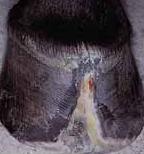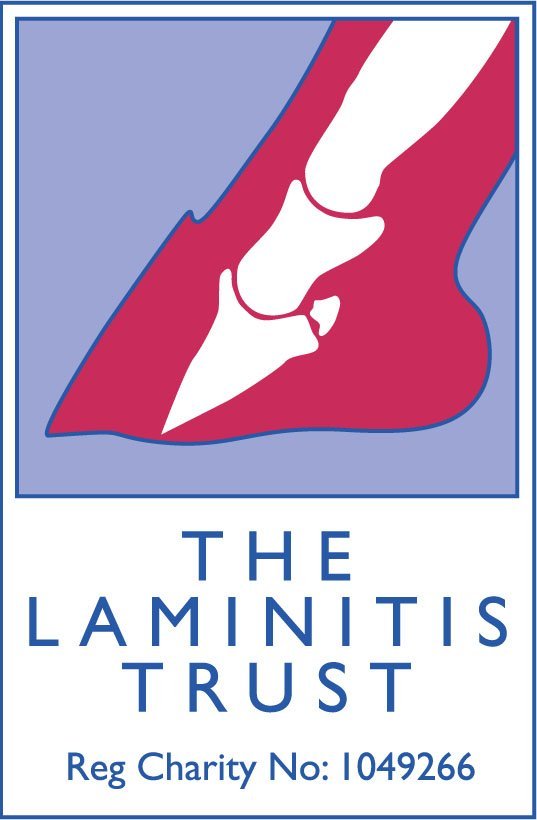 |
FACTORS AFFECTING EQUINE HOOF HORN GROWTH RATE AND QUALITY.
by Robert A Eustace FRCVS |
|
|
||||||||||||||||
|
Poor hoof horn generally manifests itself as the following clinical problems; hoof cracks, brittle feet, inability to retain shoes for a normal 5 week shoeing interval, thin soles with chronic bruising or abscessation, collapsed heels, a "pottering" gait on hard going and reluctance to stride out, lameness following steel shoeing. These problems if long standing can lead to mis-diagnosis of navicular disease when insufficient care has not been taken in identifying the source of lameness. Alternatively, poor quality horn which cannot protect against concussion, leads to demineralisation changes around the periphery of the distal phalanx sometimes described as pedal osteitis. There are four factors which influence the quality of hoof horn in horses; a) inherited factors b) diet c) environment and d) farriery. Heredity. Poor hoof conformation and poor horn quality seem to be inherited in some families of horses and ponies. There is little to be said on this aspect of the problem other than avoiding breeding from such animals.
|
||||||||||||||||
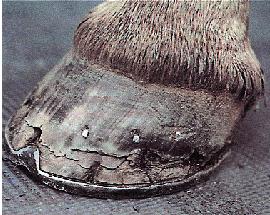 |
||||||||||||||||
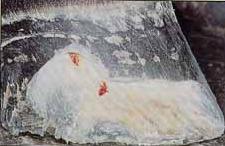 |
||||||||||||||||
|
Six year old Thoroughbred gelding showing "hollow hoof" disease, a virulent infection of the stratum medium of the hoof wall. Such cases usually require radical debridement of the overlying horn and and regular treatment with a hoof disinfectant. Best results are obtained if the resected area can be left exposed to air. The same foot seven months later, the defect has nearly grown out, the horse has since returned to full soundness. |
||||||||||||||||
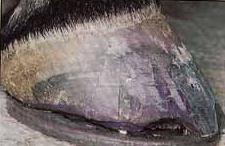 |
||||||||||||||||
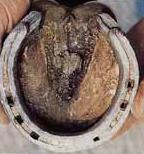 |
||||||||||||||||
|
Comparison of the shoe sizes before and after correct shoeing clearly illustrates the deficiency of length in the original shoe. |
||||||||||||||||
|
|
||||||||||||||||
|
Feet left long in the toe are subject to cracks which can be come infected. This is such an example. the crack has been debrided prior to stabilising using a pair of steel plates and fitting a shoe with two toe clips, one on either side of the crack. The crack was not filled. |
||||||||||||||||
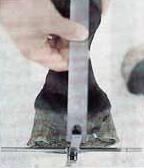 |
||||||||||||||||
|
Use of a foot gauge with a long arm helps assess the mediolateral foot imbalance and imbalance and enables the farrier to achieve flat foot fall (both branches of the shoe striking the ground at the same time). Gauges with short arms do not take into account the long axis of the limb and can lead to incorrect foot dressing. |
||||||||||||||||
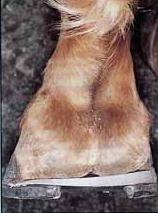 |
||||||||||||||||
|
In some instances the angulation of the limb is such that flat foot fall cannot be achieved by foot dressing alone. In this case a plastic wedge had to be fitted to raise the inside shoe branch; this achieved flat foot fall and resulted in the horse going sound. |
||||||||||||||||
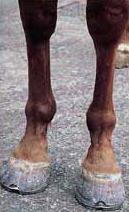 |
||||||||||||||||
|
Diet. Comben, Clark and Sutherland (1984) and Bains (1985) reported a variable improvement in hoof horn hardness and appearance following biotin supplementation at 15-20 mg/day. Buffa, Van den Berg, Verstraete and Swart (1992) reported increased rate of growth of horn following 15mg/day biotin supplementation and increased hardness in horn at the toe and quarters but not at the heels of the foot. Methionine, a sulphur rich amino acid, has been used to promote rapid horn growth, however if used at doses of more than 20 grams daily may inhibit the uptake of copper and zinc from the bowel. Kempson (1987) during ultrastructural investigations of horn described two types of defect. In 6% of cases a vacuolar degeneration of the stratum externum was seen which was biotin responsive (Type 1 defect). However, 94% of cases showed a more serious (Type 2) defect which involved degeneration of the white line and tubular horn, sometimes with parakeratosis and inclusions of blood elements in the horn . Type 2 defects did not respond to biotin supplementation, however some improvement in horn quality followed increasing the calcium and protein content in the diet. Cuddeford, Woodhead and Muirhead (1990) showed that alfalfa was a highly bioavailable source of dietary protein-bound calcium and magnesium and being a forage is ideally suited to the equine digestion. Kempson (1990) published further observations on the effect of a commercially available supplement, containing amino acids, vitamins, phospholipids and minerals which restored both Type 1 and Type 2 defects to normal horn structure with consequent improvement in the hoof conformation. Reflecting this research and the author's clinical experience, alfalfa and a proven supplement should form the basis of dietary measures to treat hoof defect cases. Environment. Good quality horn can withstand the environmental challenges encountered in most equine situations. However, poor quality horn is susceptible to a variety of secondary problems. The most important is hyper-hydration and secondary keratolytic infections. Leach and Zoerb (1983) confirmed clinical evidence that wet horn is weaker than dry horn. Kempson (1987) demonstrated that bacterial invasion of horn is common in hoof defect cases. The use of hoof oils, creams, greases and tars provides an ideal anaerobic environment which potentiates infection of susceptible feet (Eustace; unpublished observation). Ammonia in stable bedding is detrimental to horn, emphasising the need for good dry stable bedding (whitewood shavings are preferred) with the use of an oxygen permeable hoof dressing. Horses with severe horn infections such as onycomycosis, seedy toe or white line disease need an effective hoof disinfectant applied regularly to clean horn.. Certain virulent horn infections are encountered in which large areas of wall become eroded whilst the outer layer appears normal giving a "hollow hoof wall" syndrome. Radiographically these can be confused with old founder cases in that both syndromes demonstrate sub-mural radiolucencies. Such cases usually require radical hoof wall resection and topical treatment using an effective hoof disinfectant. Iatrogenic disease can be induced following the use of strong irritant chemicals on hoof horn. Products used to harden hoof horn contain 8% formaldehyde and other unspecified ingredients. Great care must be taken when handling these products, I do not recommend their use. It has to be remembered that the horse's hoof must maintain pliability to provide anti-concussive properties and prevent jarring up the limb; a hard hoof capsule is unable to dampen this jarring. Farriery. Chronic bad farriery leads to stresses in the hoof capsule which eventually result in fracture lines (hoof wall cracks). Leaving the toes long usually leads to sagittal hoof cracks (sand cracks). Continual use of shoes which provide insufficient cover at the heels commonly result in horizontal cracks at the heel quarters which grow down and cause the heel horn under the crack to break off. Long standing medio-lateral foot imbalance can result both in quarter-cracks appearing and a twisting of the hoof capsule around the long axis of the limb. In front feet it is more common to find a situation where the horse lands on the lateral toe-quarter (which has been left high by the farrier) then crushes down on the inside heel. This leads to a rotation of the hoof capsule medially giving a false "pigeon-toed" appearance with a convex lateral wall to the foot and an upright medial wall. The converse is often true in hind feet where the medial wall is left high and shod tight encouraging the horse to land on the lateral toe and the hoof capsule to rotate laterally. Any form of fine nailing in which the nails are driven into the wall and exit only a short distance above the shoe will eventually cause the best of feet to crack and split. The nails should be driven into the white line. References. Bains,
B. (1985). Buffa,
E.A., Van den Berg, S.S., Verstraaete, F.J.M. and Swart, N.G.N. (1992). Comben
N., Clark, R.J. and Sutherland D.J.B. (1984). Cuddeford,
D., Woodhead, A. and Muirhead, R. (1990) Kempson,
S.A. (1987) Kempson,
S.A. (1990) Leach,
D.H. and Zoerb, G.C. (1983) |
